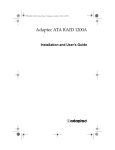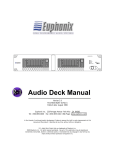Download Abit HOT ROD 100 Pro User`s manual
Transcript
Copyright and Warranty Notice The information in this document is subject to change without notice and does not represent a commitment on part of the vendor, who assumes no liability or responsibility for any errors that may appear in this manual. No warranty or representation, either expressed or implied, is made with respect to the quality, accuracy or fitness for any particular part of this document. In no event shall the manufacturer be liable for direct, indirect, special, incidental or consequential damages arising from any defect or error in this manual or product. Product names appearing in this manual are for identification purpose only and trademarks and product names or brand names appearing in this document are property of their respective owners. This document contains materials protected under International Copyright Laws. All rights reserved. No part of this manual may be reproduced, transmitted or transcribed without the expressed written permission of the manufacturer and authors of this manual. If you do not properly set the controller card settings causing the controller card to malfunction or fail, we cannot guarantee any responsibility. All brand names and trademarks shown in this manual are the property of their respective owners. Hot Rod 100 Pro User’s Manual Index CHAPTER 1. 1-1. 1-2. 1-3. 1-4. 1-5. THE INTRODUCTION OF HOT ROD 100 PRO FEATURES ............................................................ 1-1 FEATURES OF THIS IDE RAID CONTROLLER CARD ............... 1-1 SPECIFICATIONS ...................................................................... 1-2 LAYOUT DIAGRAM .................................................................. 1-4 INTRODUCTION OF ULTRA ATA/100....................................... 1-5 REQUIREMENTS FOR ATTAINING ULTRA ATA/100 ................. 1-6 CHAPTER 2. HARDWARE INSTALLATION.......................... 2-1 2-1. INSTALLING THE HOT ROD 100 PRO ....................................... 2-1 2-2. CONNECTING HARD DRIVES.................................................... 2-2 CHAPTER 3. BIOS SETTING UTILITY ................................... 3-1 3-1. SET MOTHERBOARD CMOS SETUP......................................... 3-1 3-2. ENTER THE BIOS SETTING MENU ........................................... 3-1 3-3. CREATE RAID ........................................................................ 3-2 3-4. DELETE RAID......................................................................... 3-3 3-5. DUPLICATE MIRROR DISK ....................................................... 3-4 3-6. CREATE SPARE DISK ............................................................... 3-5 3-7. REMOVE SPARE DISK .............................................................. 3-5 3-8. SET DRIVE MODE .................................................................... 3-5 3-9. SELECT BOOT DISK ................................................................. 3-6 CHAPTER 4. SOFTWARE INSTALLATION ........................... 4-1 4-1. DOS INSTALLATION................................................................ 4-1 4-2. WINDOWS 9X INSTALLATION .................................................. 4-1 4-3. WINDOWS NT 4.0 INSTALLATION ........................................... 4-5 4-4. WINDOWS 2000 INSTALLATION .............................................. 4-9 APPENDIX A. THE INTRODUCTION OF RAID ........................A-1 APPENDIX B. BIOS FLASHING USER INSTRUCTIONS .........B-1 APPENDIX C. HOT ROD UTILITY INSTRUCTIONS.................C-1 MN-197-2A0-31 Rev. 1.00 APPENDIX D. TROUBLE SHOOTING (NEED ASSISTANCE?) ...D-1 APPENDIX E. HOW TO GET TECHNICAL SUPPORT ............. E-1 Hot Rod 100 Pro Introduction of Hot Rod 100 Pro Features 1-1 Chapter 1. The Introduction of Hot Rod 100 Pro Features 1-1. Features of This IDE RAID Controller Card This IDE RAID controller card provides two IDE hard drive connectors that support the latest Ultra ATA/100 (Also known as Ultra DMA/100) hard drives with the data transfer rate of 100MB/sec. It is also backward compatible with Ultra ATA/66, Ultra ATA/33, Enhanced IDE, and Fast ATA-2. Each IDE connector supports a master/slave combination of any IDE device, including IDE, EIDE and Ultra-ATA standards. The Hot Rod 100 Pro includes EZRAID for boosting disk performance and data protection. The EZRAID function supports Striping (RAID 0), Mirroring (RAID 1), or Striping/Mirroring (RAID 0+1) operation. For Striping operation, the identical drives can read and write data in parallel to increase performance. The Mirroring operation increases read performance through load balancing and elevator sorting while creating a complete backup of your files. Striping with Mirroring operation offers both high read/write performance and fault tolerance. The EZRAID function of the Hot Rod 100 Pro offers quick and easy installation and configuration. User’s Manual 1-2 Chapter 1 1-2. Specifications 1. Chipset ! HPT370 Ultra DMA 100 IDE controller 2. BUS ! PCI 3. Specification ! Ultra DMA 100MB/sec data transfer rate ! RAID 0 (stripping mode for boosting performance) ! RAID 1 (mirroring mode for data security) ! RAID 0 + 1 (stripping and mirroring) ! Two independent ATA channels ! 256 Byte FIFO per ATA channels ! Compliant with Plug & Play ! Up to 4 IDE devices supported 4. Drive Modes Support ! Ultra 5/4/3/2/1/0 ! PIO 4/3/2/1/0 ! DMA 2/1/0 5. BIOS Support ! Friendly UI for RAID functions settings ! Auto detects and supports Ultra Mode(ATA/EIDE) transfers ! Recognizes drives up to 128 GB 6. Operating System Supports ! Microsoft DOS 5.X and above ! Microsoft Windows 95/98 ! Microsoft Windows 2000 ! Microsoft Windows NT4.0 ! ABIT Gentus 2.0 or later version (Linux) Hot Rod 100 Pro Introduction of Hot Rod 100 Pro Features 1-3 Table 1-1: Hot Rod 100 Pro specifications Bus: PCI Drive Transfer Rate: 100MB/sec burst w/Ultra ATA/100 devices Number of Supporting Drives: 4 Drive Modes: Ultra DMA mode 5/4/3/2/1/0 DMA mode 2/1/0 PIO mode 4/3/2/1/0 Devices: ATAPI Hard Drives Operating Systems: Microsoft DOS 5.X and above Microsoft Windows 95/98 Microsoft Windows 2000 Microsoft Windows NT4.0 ABIT Gentus 2.0 (Linux) BIOS: 1MB Flash ROM Auto ID/Configure Max. Storage: 128GB Supports ACPI function Hardware: Bus mastering Triple data channels (all DMA 33/66/100) Utilities: ABIT Vivid Installation User’s Manual 1-4 Chapter 1 1-3. Layout Diagram Figure 2-1: Hot Rod 100 Pro controller card component locations Hot Rod 100 Pro Introduction of Hot Rod 100 Pro Features 1-5 1-4. Introduction of Ultra ATA/100 Ultra ATA/100 enhances existing Ultra ATA/66 technology by increasing both performance and data integrity. This new high-speed interface enhances the Ultra ATA/66 and Ultra/33 burst data transfer rate to 100 Mbytes/sec. The result is maximum disc performance using the current PCI local bus environment. Figure 2-2 shows you the difference between the Ultra ATA/33 and Ultra ATA/66 Cable. Figure 2-2: The difference between Ultra ATA/33 and Ultra ATA/66 Conductor Cables In order to achieve the Ultra ATA100 transfer speed you must have a system which supports Ultra ATA/100 and equipped with, an Ultra ATA HDD, and Ultra ATA/66 cable. The correct drivers must be loaded and an Ultra ATA/66 specific data cable must be used. The Ultra ATA/66 cables use a Cable Select method rather than a Master / Slave scheme. The drive must be jumped to enable Cable Select. The Boot drive (C:) is attached to the connector on the end of the cable and the second drive is attached to the middle connector. If an Ultra ATA/66 specific cable is not used, the drive will default to Ultra ATA/33 mode. Figure 2-3 shows you a photo of an Ultra ATA/66 Conductor Cable. An Ultra ATA/66 cable is a 40-pin, 80conductor cable with a black connector on one end, a blue connector on the other end and a gray connector in the middle. The additional 40 wires are ground lines that reduce the crosstalk caused by the electro-magnetic fields that build up during high-speed data transfers. In addition, Figure 2-3: Photo of an Ultra ATA/66 Cable line 34 on the cable should be notched or cut (this may be difficult to see). User’s Manual 1-6 Chapter 1 Ultra ATA/100 is backwards compatible with all Ultra ATA/33/66 systems, but it will be limited in its transfer mode to Ultra ATA/33/66 (Ultra DMA Mode 2 - 33 Mbytes/sec or Ultra DMA Mode 2 - 66 Mbytes/sec) or PIO Mode 4 (16.6 Mbytes/sec). The Ultra ATA/100 hard drives are 100 percent backward compatible with both Ultra ATA/33/66, DMA and with existing ATA (IDE) hard drives, CD-ROM drives, and host systems. The Ultra ATA/100 protocol and commands are designed to be compatible with existing ATA (IDE) devices and systems. Although a new 40-pin, 80-conductor cable is required for Ultra ATA/100, the chip set pin connector remains the same at 40. Hard drives that support Ultra ATA/100 also support Ultra ATA/33/66 and legacy ATA (IDE) specifications. 1-5. Requirements for Attaining Ultra ATA/100 There are four requirements for attaining Ultra ATA/100: 1. The drive must support Ultra ATA/100. 2. The motherboard and system BIOS (or an add-in controller) must support Ultra ATA/100. 3. The operating system must support Direct Memory Access (DMA); Microsoft Windows 2000, Windows NT, Windows 98, and Windows 95B (OSR2) support DMA. 4. The cable must be 80-conductor; the length should not exceed 18 inches. If all the above requirements are met, you can enjoy the Ultra ATA/100 features of your computer system. Note For obtaining the performance of Hot Rod 100 Pro, please use the Ultra ATA/66 cable that comes with the package. Hot Rod 100 Pro Hardware Installation 2-1 Chapter 2. Hardware Installation This IDE RAID controller card is as easy to install as any other computer peripheral. It uses the Plug & Play design concept. First, plug this controller card into any PCI slot on your motherboard. Second, connect the Ultra ATA/100 devices to its IDE connectors using the included Ultra ATA/66 cables. 2-1. Installing the Hot Rod 100 Pro Installing this controller card into your computer is a simple process. You just have to insert the card into any available PCI slot on the motherboard (see figure below). ➠ Open your computer case. ➠ Remove the inside slot cover of an available PCI slot on the motherboard. ➠ Insert this controller card into the open slot. ➠ Fasten the controller card bracket to the case. ➠ Attach the two-threaded IDE HDD LED connector of the computer case to HDD-LED connector on this controller card. (Note: Watch out the pin orientation.) ➠ Connect the Ultra ATA/100 HDD to the IDE connectors on this controller card. Figure 2-1: The installation of the Hot Rod 100 Pro controller card User’s Manual 2-2 Chapter 2 2-2. Connecting Hard Drives This IDE RAID controller card provides two IDE hard drive connectors that support Ultra ATA/100 (Also known as Ultra DMA/100) specification. How to install the Ultra ATA/66 Cable Assembly: " Connect the BLUE connector of the first Ultra ATA/66 cable to the IDE1 connector on this IDE RAID controller card. (Note that the colored cable edge indicates Pin # 1.) " Connect the BLACK connector of this Ultra ATA/66 cable to the Master Drive. " Connect the GRAY connector of this Figure 2-2. How to connect an ATA/66 Cable to this IDE RAID controller Ultra ATA/66 cable to the Slave Drive (if you are using more than two hard drives). " For the second Ultra ATA/66 cable connection, please follow the previous procedure. " Each connector on the Ultra ATA/66 cable assembly has a small polarization tab centrally located on the body of the plastic. This fits into the matching slot on the mating plugs on this IDE RAID controller card and the drives, thus assuring positive mating (pin #1 to pin #1). Please refer to figure 2-2. " When two hard drives are attached, configure each drive as a Master Table 2-1: Hot Rod 100 Pro Hard Drive Setup Total Drives IDE 1 IDE 2 (with no Slave attached) and each 1 Master --- hard drive on a separate channel. 2 Master Master Check the hard drive setup for 3 Master and Slave Master 4 Master and Slave Master and Slave details on Master and Slave settings as shown in table 2-1. For better performance, use all available connectors before chaining a slave drive. " For optimal performance, install all identical drives of the same model and capacity. The drives’ matched performance allows the array to the function better as a single drive. " For maximum IDE fault tolerance, each mirrored pair should be installed on separate IDE connectors. Hot Rod 100 Pro Hardware Installation 2-3 Connecting hard drives with onboard ATAPI CD-ROM: Please DO NOT attach ATAPI devices to this IDE RAID controller card. Hot Rod 100 Pro is for hard drives only. ATAPI CD-ROM ATAPI IDE CD-ROM drives or other devices can be installed on motherboard or add-on IDE controllers. No configuration is necessary on the motherboard BIOS setup. Bootable Secondary Connecting hard drives with onboard IDE controller: This IDE RAID controller card can coexist with onboard or add-on IDE controller(s) and hard drives installed. If the motherboard’s CMOS has a “boot to SCSI” option, it is possible to boot from this IDE RAID controller card and still recognize the onboard non-bootable drives. If the motherboard’s CMOS does not allow booting to SCSI, the boot drive must be Secondary Bootable attached on the onboard IDE controller. User’s Manual 2-4 Chapter 2 Connecting hard drives with SCSI controller: This IDE RAID controller card is bootable with a SCSI controller in the system. The adapter with the lower BIOS address will be bootable. If it is necessary to change the boot sequence, swap the Hot Rod 100 Pro slot position with that of SCSI card’s PCI slot. Secondary Hot Rod 100 Pro Bootable BIOS Setting Utility 3-1 Chapter 3. BIOS Setting Utility In this chapter we will discuss the BIOS setting procedure of this IDE RAID controller card before starting the software installation. 3-1. Set Motherboard CMOS Setup No changes are necessary in the motherboard CMOS setup for resources or drive types. As this IDE RAID controller card is a PCI Plug and Play device, the motherboard’s PCI PnP BIOS automatically assigns the Interrupt and Port address. For this IDE RAID controller card to be the bootable IDE controller, confirm in the motherboard’s Standard CMOS Setup that the drive types (for hard disk drives) are set for “Not Installed” or “None”. Or use the “Boot to SCSI” option, if this setting is available in the motherboard’s BIOS. No changes are needed for CD-ROM drives that are attached to the motherboard IDE controller. 3-2. Enter the BIOS Setting Menu After you have installed this IDE RAID controller card and attached the hard disks, reboot your system. Press <CTRL> and <H> key while booting up the system to enter the BIOS setting menu. The main menu of BIOS Setting Utility appears as shown below: User’s Manual 3-2 Chapter 3 For selecting the options in the menu, you may: # Press F1 to view array status. # Press ↑↓ (up, down arrow) to choose the option you want to confirm or to modify. # Press Enter to confirm the selection. # Press Esc to return to the top menu. 3-3. Create RAID This item allows you to create a RAID array with the hard disks attached to this IDE RAID controller card. After you have selected the function you want in the main menu, press the <Enter> key to enter the sub menu as shown below: Warning All the data stored in the hard disks will be lost after created RAID! Hot Rod 100 Pro BIOS Setting Utility 3-3 Array Mode: This item allows you to select the appropriate RAID mode for the desired array. There are four modes to choose. ✏ Striping (RAID 0): This item is recommended for high performance usage. Requires at least 2 disks. ✏ Mirror (RAID 1): This item is recommended for data security usage. Requires at least 2 disks. ✏ Striping and Mirror (RAID 0+1): This item is recommended for data security and high performance usage. Allows Mirroring with a Strip Array. Requires 4 disks only. ✏ Span (JBOD): This item is recommended for high capacity without redundancy or performance features usage. Requires at least 2 disks. Select Disk Drives: This item allows you to select the disk drives to be used with the RAID array. Block Size: This item allows you to select the block size of the RAID array. There are five options: 4K, 8K, 16K, 32K, and 64K. Start Creation Process: After you have made your selection, choose this item and press <Enter> to start creation. 3-4. Delete RAID This item allows you to remove a RAID Array on this IDE RAID controller card. Note: After you have made and confirmed this selection, all the data stored in the hard disk will be lost. (The entire partition configuration will be deleted too.) User’s Manual 3-4 Chapter 3 3-5. Duplicate Mirror Disk This item allows you to select the disk you wish to duplicate in preparation for a “Mirror Disk Array”. After you had selected the function you want in the main menu, press the <Enter> key to enter the sub menu as shown below: ✏ Select Source Disk: This item is to select the source disk. The size of the source disk must be smaller or equal to the one of the target disk. ✏ Select Target Disk: This item is to select the target disk. The size of target disk must be greater or equal to the one of the source disk. ✏ Start Duplicating Process: After you had selected this item, the BIOS setting will take up to 30 minutes to run the duplication. Please wait or you may press <Esc> to cancel. Hot Rod 100 Pro BIOS Setting Utility 3-5 3-6. Create Spare Disk This item allows you to select the disk to be used as a spare for a Mirror Disk Array. 3-7. Remove Spare Disk This item allows you to remove the spare disk from a Mirror Disk Array. 3-8. Set Drive Mode This item allows you to select the drive transfer mode for the hard disk(s) attached to this IDE RAID controller card. Use the up/down arrow to select the menu option to “Set Drive Mode” and press <Enter>. In the Channel Status, select the channel you would like to set and press the <Enter> key. There will be an asterisk mark in the parentheses indicating that the channel selection has been done. Choose the mode from the pop-up menu. You can choose from PIO 0 ~ 4, MW DMA 0 ~ 2, and UDMA 0 ~ 5. User’s Manual 3-6 Chapter 3 3-9. Select Boot Disk This item allows you to select the boot disk among the hard disk(s) attached to this IDE RAID controller card. Use the up/down arrow to select the menu option to “Select Boot Disk” and press <Enter>. In the Channel Status, select the channel you would like to set as the bootable disk and press the <Enter> key. There will be an asterisk mark in the parentheses indicating that the channel selection has been done. Note: Your PC or server must be configured to use the Hot Rod 100 Pro as the bootable controller. The system will then use the bootable array as the (fixed) boot C: drive. Hot Rod 100 Pro Software Installation 4-1 Chapter 4. Software Installation In this chapter we will show you the driver installation procedure under various operating systems. 4-1. DOS Installation This IDE RAID card BIOS supports DOS 5.x (or above) and Windows 3.1x without software driver. 4-2. Windows 9x Installation Step 1: After the Windows 9x operating system had been installed and rebooted successfully, go to the “Control Panel” $ “System Properties” $ “Device Manager”. You can see the driver is not yet installed, and there is a device of “? PCI Mass Storage Controller” under “Other devices”. User’s Manual 4-2 Chapter 4 Step 2: Click the right button of your mouse on the “? PCI Mass Storage Controller”, and then go to “Driver” tab. Click “Update Driver” to go to the next step. Step 3: The wizard is going to install the PCI Mass Storage Controller. Click “Next >” to go to the next step. Step 4: Choose “Display a list of all the drivers in a specific location…” and click “Next >” to go on. Hot Rod 100 Pro Software Installation 4-3 Step 5: Choose “SCSI controllers” and click “Next >” to go on. Step 6: Click “Have Disk…” to go on. Step 7: Insert the driver disk that comes with the Hot Rod 100 Pro and type the path in the text box “a:\WIN” (“a:\” is your floppy drive letter), or “E:\Drivers\Win9x” (E:\ is your CD-ROM drive letter). Click “OK” to go on. Step 8: Choose “HPT370 UDMA/ATA100 RAID Controller” and click “Next >” to go on. User’s Manual 4-4 Chapter 4 Step 9: Windows is now ready to install the driver. Click “Next >” to go on. Step 10: Windows has finished installing the driver. Click “Finish” to end the installation. Step 11: After rebooting the system, go to the “Control Panel” $ “System Properties” $ “Device Manager”. Now you can see the driver is installed under the item of “SCSI controllers”. Hot Rod 100 Pro Software Installation 4-5 4-3. Windows NT 4.0 Installation Note # Before you start to install Windows NT 4.0, you have to create a driver disk for the Hot Rod 100 Pro. You can copy the Ultra ATA/100 (Hot Rod 100) driver files from the CD-Title that comes with this controller card. The path for the Ultra DMA/100 driver files is “E:\drivers\winnt (E is your CD-ROM drive letter).” # Please note two things before you copy the driver files to diskette. First, the driver files must be copied to the root directory of the diskette. Second, you have to set your system to “Show all files”. Otherwise you will be unable to copy some important system files to diskette. Installing drivers during Windows NT installation: If the NT 4.0 is first installed on the ATA100 drive connected to the Hot Rod 100 Pro controller card, follow the following installation procedure: Step 1: Install this IDE RAID controller card in any available PCI slot and then connect your ATA100 hard disk to it (refer to hardware installation). Step 2: Set your system to boot from “Drive A” and then insert the Windows NT installation diskette 1/3. Power on your computer. Installation Note If you are installing NT 4.0 from a CD-ROM, please press the “F6” key immediately when the message “Setup is inspecting your computer’s hardware configuration…” appears. Then press “S” to configure an additional adapter (Hot Rod 100 Pro). Step 1: The setup program will display a message about installing mass storage devices (see figure left) while you install NT4.0. Please press “S” to install Hot Rod 100 Pro driver. User’s Manual 4-6 Chapter 4 Step 2: Select “Other, requires disk provided by a hardware manufacturer”, and then press <ENTER>. Step 3: Insert the driver disk into drive A and press <ENTER>. Step 4: Use the UP or DOWN arrow key to move the highlight to the mass storage device you want and press <ENTER> to continue setup. Step 5: Windows NT setup has recognized this IDE RAID controller card. Press <ENTER> to continue setup. Hot Rod 100 Pro Software Installation 4-7 Step 6: After you configure your hard disk and specify the installation path, the NT setup will ask you to insert this IDE RAID controller card driver disk into drive A again. Insert the driver disk, and then press <ENTER> to continue setup. If you have followed the steps described above, you should be finished installing your Hot Rod 100 Pro controller. For the rest of the Windows NT installation steps, please follow the instructions displayed in the NT setup program. Installing drivers with existing Windows NT: If there is an existing NT 4.0 file system, you can install this IDE RAID controller card into the existing system by the following procedure: Step 1: Go to “Control Panel”, and then enter “SCSI Adapters”. Step 2: Select “Drivers”, and then click “Add…”. User’s Manual 4-8 Chapter 4 Step 3: Click “Have Disk…” to go on. Step 4: Insert this IDE RAID controller card driver disk into drive A, and then click “OK.” Step 5: Click “OK” to go on. Step 6: Enter “A:\” in the blank space, and then click “Continue”. Step 7: Click “Yes” to restart your computer. Hot Rod 100 Pro Software Installation 4-9 4-4. Windows 2000 Installation Note If you want to install the Windows 2000 operating system on the hard drive connected to Hot Rod 100 Pro, please refer to the NT4.0 installation procedure. The following procedure is used only when you don’t want to install the Windows 2000 operating system onto the hard drive connected to Hot Rod 100 Pro. Step 1: Install the Hot Rod 100 Pro and reboot the system. Windows will detect the new hardware automatically. Click “Next>” to go to the next step. Step 2: Choose “Display a list of all the drivers in a specific location…” and click “Next >” to go on. Step 3: Choose “SCSI and RAID controllers” and click “Next >” to go on. User’s Manual 4-10 Chapter 4 Step 4: Click “Have Disk…” to go on. Step 5: Insert the driver disk that comes with the Hot Rod 100 Pro and type the path in the text box “A:\2K” (“A:\” is your floppy drive letter), or “D:\Drivers\Win2k” (D:\ is your CD-ROM drive letter). Step 6: Choose “HPT370 UDMA/ATA100 RAID Controller” and click “Next >” to go on. Step 7: Windows is now ready to install the driver. Click “Next >” to go on. Hot Rod 100 Pro Software Installation 4-11 Step 8: Click “Yes” to go on. Step 9: Windows has finished installing the driver. Click “Finish” to end the installation. Step 10: Click “Yes” to restart the system. Step 11: Go to the “Control Panel” $ “System Properties” $ “Device Manager”. Now you can see the driver is installed under the item of “SCSI and RAID controllers”. User’s Manual 4-12 Hot Rod 100 Pro Chapter 4 The Introduction of RAID A-1 Appendix A. The Introduction of RAID What is RAID? RAID (Redundant Array of Inexpensive/Independent Disks) technology was developed to offer a combination of outstanding data availability, excellent performance, and high capacity that one single disk drive can not match. A RAID array is defined as two or more disks grouped together to appear as one single device to the host system, which can tolerate the failure of a drive without losing data, and which can operate independently from each other. To manage MTBF (Mean Time Between Failures) and prevent any single drive failure causing data loss within an array, UC Berkeley scientists proposed five types of redundant array architectures, defining them as RAID levels 1 through 5. Each RAID level has its own strengths and weaknesses, and is well suited for certain types of applications and computing environments. RAID 1, RAID 3 and RAID 5 of these five types are commonly used. RAID 2 and RAID 4 do not offer any significant advantages over these other types. RAID 3 is designed for single-user or data-intensive environments, such as imaging or data acquisition that access extremely large sequential records. This leaves RAID 1 and RAID 5 as the RAID levels applicable for networked and transaction processing-based environments utilizing NetWare, Windows NT, Unix, and OS/2. In addition to these five redundant array architectures, it has become popular to refer to a non-redundant array of disk drives as RAID 0 array. Why RAID? Data security is a very important issue for system administrators. They have to adopt efficient methods of data protection to guard against potential losses due to drive failures. Tape-based backups are used to be one solution for data security, but this method is becoming a task more difficult. The demand to store increasingly large software applications will impel disk capacities to exceed 10GBs by the end of 1997. Slow, cumbersome tape backup solutions lose their effectiveness for servers and workstations. RAID technology is another solution for data security. There are a number of factors responsible for the growing adoption of arrays for critical network storage. Because today’s applications create larger files, the need for network storage has increased proportionately. To accommodate expanding storage requirements, users are adding disk drives --- raising the probability of drive failures. In addition, the development of CPU speed has exceeded data transfer rates to storage media, causing I/O bottlenecks for networking applications. User’s Manual A-2 Appendix A RAID technology overcomes these challenges by providing a combination of outstanding data availability, extraordinary and highly scalable performance, as well as high capacity. RAID provides real-time data rebuild when a disk drive fails, increasing system uptime and network availability, while protecting against the loss of data. Multiple drives working together also increases system performance. The RAID Levels RAID Level 0: .. . Striped Disk Array without Fault Tolerance Block D Block C Block B Block A RAID 0 is typically defined as a nonredundant collection of striped disk drives. It doesn’t provide data protection but it offers very high data throughput, especially for large files. RAID 0 does not deliver any fault tolerance. All data is lost if any drive in the array fails. Block A Block B It is intended for non-critical data requiring Block C Block D high performance. Block E Block F Block G etc … Disk 0 Disk 1 Hot Rod 100 Pro The Introduction of RAID A-3 RAID Level 1 Mirroring and Duplexing Block D Block C Block B Block A RAID 1 provides 100% redundancy by mirroring one drive to another one. In the event of a disk drive failure, the array controller will automatically switch the read/write activity to another drive. Each individual drive can execute simultaneous read operations. Mirroring Block A Block A Block B $ Mirror Block B Block C Block C Block D Block D Disk 0 Disk 1 thus doubles the read performance of a single drive and leaves the write performance unchanged. RAID 1 is a good entry-level redundant system, since only two drives are required. However, the cost of RAID 1 is higher because one drive has to be used to store duplicate data. RAID Level 0+1 .. . Performance and Security Block D Block C Block B Block A RAID 0+1, which uses Hamming error correction codes, is intended for use with drives which do not have built-in error detection. Because the check method of Hamming code is very complicated, and more than one drive is required to store ECC Block A Disk 0 Block C Block E Block G Stripe Block B Disk 1 Block D Block F Block H Block A Block C Disk 2 Block E Block G information, RAID 2 offers no significant advantages over RAID 3. Stripe Block B Block D Disk 3 Block F Block H User’s Manual A-4 Appendix A RAID Level 2 Disk Striping with errorcorrection code (ECC) Block D Block C Block B Block A RAID 2, which uses Hamming error correction codes, is intended for use with drives which do not have built-in error A0 A1 detection. Because the check method of A2 B0 B1 B2 Hamming C0 C1 C2 Code D0 D1 D2 Disk 0 Disk1 Disk 2 …. Hamming code is very complicated, and more than one drive is required to store ECC Disk3 information, RAID 2 offers no significant advantages over RAID 3. RAID Level 3 Parallel transfer with parity Block D Block C Block B Block A Stripe 0 RAID 3 uses a separate drive to store parity and stripes data on a byte-by-byte basis Stripe 1 Stripe 2 Stripe 0, 1, 2 Parity A0 A1 A2 A Parity B0 B1 B2 B Parity C0 C1 C2 C Parity D0 D1 D2 D Parity Disk 0 Disk1 Disk 2 Disk3 across all of the data disks in the array. Because each I/O accesses all drives in the array, RAID 3 does not support multiple, simultaneous read/write requests. It is optimized for large, sequential data requests. RAID Level 4 Independent Data disks with shared parity disk DATA ABCD RAID 4 is identical to RAID 3 except the Block 0 Block 1 Block 2 Block 0, 1, 2 Parity block level stripes are used. A0 A1 A2 A Parity RAID 4 supports multiple simultaneous B0 B1 B2 B Parity C0 C1 C2 C Parity read requests. However, since all write D0 D1 D2 D Parity operations require that parity data to be Disk 0 Disk1 Disk 2 Disk3 updated each time, they can not be overlapped. And so the RAID 4 offers no significant advantages over RAID5. Hot Rod 100 Pro The Introduction of RAID A-5 RAID Level 5 Independent Data disks with distributed parity blocks DATA ABCD RAID 5 also stripes data at a block level across several drives. But it distributes A Block B Block C Block D Block parity among the drives, which avoids the B0 C0 0 Parity A1 B1 1 Parity D1 A2 2 Parity C2 D2 dedicated parity drive. Each drive takes 3 Parity B3 C3 D3 turns storing parity information for a Disk 0 Disk1 Disk 2 Disk3 different series of stripes. RAID 5 can A0 write bottleneck caused by the single execute read/write to disk drives either in parallel or independently. User’s Manual A-6 Appendix A Which RAID Level Should I Use? Many different disk array configurations are possible, depending on end-user requirements and the goals of the manufacture. Each controller design has a different functionality to accomplish specific performance and data availability goals. Therefore, no individual RAID level is inherently superior to any other. Each of the five array architectures is well suited for certain types of applications and computing environments. The follow table summarizes the strengths and weaknesses of each RAID level. RAID Level Min. No. of Drive s RAID 0 2 Characteristics / Strengths Description ! ! Striped Disk Array without Fault Tolerance Mirroring and Duplexing ! ! ! ! ! RAID 1 2 ! ! Performance and Security ! ! RAID 0+1 4 ! RAID 2 Not used in LAN Hot Rod 100 Pro Disk Striping with error-correction code (ECC) ! Highest I/O Performance Very simple design Easy to implement 100% redundancy of data Twice the Read transaction rate of a single disk, same Write transaction rate as single a disk Simplest RAID storage subsystem design The combination of Striping and Mirroring Offers the speed advantages of RAID level 0 combined with the data reliability advantages of RAID level 1 Previously used for RAM error environments correction (known as Hamming Code) and in disk drives before the use of embedded error correction Weaknesses ! ! No redundancy One drive fails, all data is lost High redundancy cost overhead ! Need twice the data capacity ! No practical use The Introduction of RAID ! Parallel transfer with parity A-7 ! ! ! RAID 3 3 ! ! RAID 4 Independent Data disks with shared parity disk 3 ! ! ! ! Independent Data disks with distributed parity blocks ! ! ! RAID 5 3 ! ! Very high Read data transfer rate Very high Write data transfer rate Excellent performance for large, sequential data requests Low ratio of ECC (Parity) disks to data disks means high efficiency Very high Read data transaction rate High aggregate Read transfer rate Low ratio of ECC (Parity) disks to data disks means high efficiency Highest Read data transaction rate Medium Write data transaction rate Best cost/performance for transaction-oriented networks Supports multiple, simultaneous Read and Write Low ratio of ECC (Parity) disks to data disks means high efficiency ! ! ! Doesn’t support multiple, simultaneous Read and Write requests Transaction rate equal to that of a single disk drive at best (if spindles are synchronized) Worst Write transaction rate and Write aggregate transfer rate ! ! Write performance is slower than RAID 0 or RAID1 Note: Hot Rod 100 Pro only supports RAID level 0, 1, and 0+1 currently. User’s Manual A-8 Hot Rod 100 Pro Appendix A BIOS Flashing User Instructions B-1 Appendix B. BIOS Flashing User Instructions This IDE RAID controller card is equipped with 1 Mbit flash BIOS onboard. If you receive information about an update for this IDE RAID controller card BIOS from our website (http://www.abit.com.tw) or technical support, download the BIOS file and save it under the name “BIOS”, then follow the procedure below to upgrade this IDE RAID controller card BIOS: Step 1: Copy the files “load.exe (included in this IDE RAID Driver Disk)” and “BIOS” to a new floppy. Step 2: Reboot your system and go into the pure DOS environment. Step 3: Insert the floppy that contains the files “load.exe” and “BIOS” into drive A. Step 4: At the “A:\>” prompt, type “load BIOS” and then press “enter”. Step 5: Remove the floppy A, and then restart your system. User’s Manual B-2 Hot Rod 100 Pro Appendix B Hot Rod Utility Instructions C-1 Appendix C. Hot Rod Utility Instructions In order to provide you with the on-screen monitoring function about the device information of disk array, you may install the “Hot Rod Utility” onto your system. Please insert the Hot Rod 100 Pro CD-Title into your CD-ROM drive. It should execute the program automatically. If not, you can go to the CD location and execute the execution file from the main directory of the CD-Title. After it is executed, you will see the screen shot below. Move the cursor to “Utility” and click on it to go to the next step. Move the cursor to “RAID Status Monitor Utility” and click on it to go to the next step. Click “Next>” to go on. User’s Manual C-2 Appendix C Type in the information of your name and company and then click “Next>” to go on. Now you can choose the folder for the destination location you want. We suggest you use the default folder as the destination location. When you are sure of the folder, click “Next>” to go on. Now you can select the program folder. The setup wizard will add program icons to those program folders listed. Click “Next>” to go on. The system will start copying files. Click “Next>” to go on. Hot Rod 100 Pro Hot Rod Utility Instructions C-3 When the installation is completed, choose “Yes, I want to restart my computer now.” In the check box and click “Finish” to end the setup. After the system restart, you can run this “Stripe & Mirror Settings” monitoring program. Move the cursor to where the execution file is, shown left. The monitoring screen pops up. Note that there will be a shortcut icon appears in the tool bar. This is used for bringing out the screen again after you had clicked the “Minimize” icon on the upper right corner of the screen. This short cut icon will disappear after you click the “Exit” icon. Now you are in the monitoring screen. Your current device allocation is viewable at a glance. Move the cursor to the drive icon you want to view and click on it. User’s Manual C-4 Hot Rod 100 Pro Appendix C Trouble Shooting (Need Assistance?) D-1 Appendix D. Trouble Shooting (Need Assistance?) Q&A Q: May I use hard drives with different capacity or transfer mode? A: In order to get optimized performance, we suggest using hard drives with the same model. Q: How to assign a booting device? A: You may press <Ctrl><H> to assign a booting device in RAID BIOS (user’s manual section 3-9). Q: Why can’t I see correct capacity in FDISK utility? A: It's a well-known issue of win95/98's FDISK utility. If an IBM 75GB hard disk DTLA 307075 only gets 7768MB in Win95/98’s FDISK utility, please contact Microsoft for a latest version of FDISK utility or download IBM's Disk Manager DiskGo! 2.5 to fix it. For windows 2000, there is no such a 64GB issue. http://www.storage.ibm.com/techsup/hddtech/welcome.htm Q: How to create a striping and mirror array (RAID 0+1)? A: You need four drives (Appendix A), every two of them on the same channel/cable build a striping array. Then create a mirror array by these two striping arrays (Appendix A-3). (i) Press <Ctrl> <H> to setup configuration (ii) Choose item 1 to Create RAID. (iii) Choose item 1 to set Array Mode as Striping and Mirror (RAID 0+1). (iv) Choose item 2 to Select Disk Drives. There are two striping arrays built automatically and you only have to enter twice. (v) Choose item 4 to Start Creation Process. (vi) Press <Esc> to finish setting and leave RAID BIOS. Q: How to rebuild a mirror array when one of the drives corrupts? A: You need to delete previous array setting, duplicate the data, then rebuild a new array setting (user’s manual 3-5). User’s Manual D-2 Appendix D (i) Press <Ctrl><H> to setup configuration (ii) Choose item 2 to Delete Array. (iii) Choose item 3 to Duplicate Mirror Disk. (iv) Choose sub item 1 to Select Source Disk, the one with data on it. (v) Choose sub item 2 to Select Target Disk, the brand new and empty one. (vi) Choose sub item 3 to Start Duplication Process. (vii) After duplication process completes, press <Esc> to leave RAID BIOS. Q: Why I see “NO ROM BASIC SYSTEM HALTED” when booting? A: There isn’t any activated primary partition in you system. Please use FDISK or any other utilities to create/set one. Hot Rod 100 Pro Trouble Shooting (Need Assistance?) D-3 Do & Don’t 1. Do always use the same model drives to achieve best quality and performance. Different firmware has different timing characteristic, thus may somewhat decrease the RAID performance. 2. If you have two drives, do connect them on two different channels as master drive please. 3. When attach drives to the RAID card, do make sure the master/slave jumper settings are correct please. If there is only one drive on one channel/cable, do set it as master or single drive. 4. Do always use 80 conductor cables please. 5. Don’t connect any ATAPI devices (CD-ROM, LS-120, MO, ZIP, removable HD etc.) on the RAID card please. 6. For the best performance result, please do use the Ultra ATA 66/100 Hard Disks. User’s Manual D-4 Appendix D % Technical Support Form ! Company Name: ☎ Phone Number: " Contact Person: # Fax Number: & E-mail Address: IDE Card Product Name Motherboard Manufacturer, Model Name and Chipset type Operating System Type Hardware name CPU Type and Speed HDD IDE1 IDE2 CDIDE1 IDE2 ROM Drive System Memory Size (SDRAM) Add-On Card ' Problem Description: Hot Rod 100 Pro * IDE Card BIOS Version IDE Card Software and Driver Version * * * * * * Type * * Specifications How to Get Technical Support E-1 Appendix E. How to Get Technical Support (From our website) http://www.abit.com.tw (In North America) http://www.abit-usa.com (In Europe) http://www.abit.nl Thank you for choosing ABIT products. ABIT sells all our products through distributors, resellers and system integrators, we have no direct sales to end-users. Before sending email for tech support please check with your resellers or integrators if you need any services, they are the ones who sold you your system and they should know best as to what can be done, how they serve you is a good reference for future purchases. We appreciate every customer and would like to provide the best service to you. Providing fast service to our customers is our top priority. However we receive many phone calls and a huge amount of email from all over the world. At the present time it is impossible for us to respond to every single inquiry. Therefore it is quite possible that if you send an email to us that you may not receive a response. We have done many compatibility tests and reliability tests to make sure our products have the best quality and compatibility. In case you need service or technical support, please understand the constraint we have and always check with the reseller who sold the product to you first. To expedite service, we recommend that you follow the procedures outlined below before contacting us. With your help, we can meet our commitment to provide the best service to the greatest number of ABIT customers: 1. Check the Manual. It sounds simple but we have taken a lot of care in making a well written and thorough manual. It is full of information that doesn't only pertain to motherboards. The CD-ROM included with your board will have the manual as well as drivers. If you don't have either one go to our Program Download Area of the website or FTP server at: http://www.abit.com.tw/download/index.htm 2. Download latest BIOS, software or drivers. Please go to our Program Download area on our website to check to see if you have the latest BIOS. They are developed over periods of time to fixes bugs or incompatibilities. Also please make sure you have the latest drivers from your peripheral cards makers! 3. Check the ABIT Technical Terms Guide and FAQ on our website. We are trying to expand and make the FAQs more helpful and information rich. Let us know if you have any suggestions. For hot topics check out our HOT FAQ! User’s Manual E-2 Appendix E 4. Internet Newsgroups. They are a great source of information and many people there can offer help. ABIT's Internet News group, alt.comp.periphs.mainboard.abit, is an ideal forum for the public to exchange information and discuss experiences they have had with ABIT products. Many times you will see that your question has already been asked before. This is a public Internet news group and it is reserved for free discussions, Here is a list of some of the more popular ones: alt.comp.periphs.mainboard.abit alt.comp.periphs.mainboard comp.sys.ibm.pc.hardware.chips alt.comp.hardware.overclocking alt.comp.hardware.homebuilt alt.comp.hardware.pc-homebuilt 5. Ask your reseller. Your ABIT authorized distributor should be able to provide the fastest solution to your technical problem. We sell our products through distributors who sell to resellers and stores. Your reseller should be very familiar with your system configuration and should be able to solve your problem much more efficiently than we could. After all, your reseller regards you as an important customer who may purchase more products and who can urge your friends to buy from him or her as well. They integrated and sold the system to you. They should know best what your system configuration is and your problem. They should have reasonable return or refund policies. How they serve you is also a good reference for your next purchase. 6. Contacting ABIT. If you feel that you need to contact ABIT directly you can send email to the ABIT technical support department. First, please contact the support team for the branch office closest to you. They will be more familiar with local conditions and problems and will have better insight as to which resellers offer what products and services. Due to the huge number of emails coming in every day and other reasons, such as the time required for problem reproduction, we will not be able to reply to every email. Please understand that we are selling through distribution channels and don't have the resources to serve every end-user. However, we will try to do our best to help every customer. Please also remember that for many of our technical support team English is a second language, you will have a better chance of getting a helpful answer if your question can be understood in the first place. Be sure to use very, simple, concise language that clearly states the problem, avoid rambling or flowery language and always list your system components. Here is the contact information for our branch offices: Hot Rod 100 Pro How to Get Technical Support E-3 In North America and South America please contact: ABIT Computer (USA) Corporation 46808 Lakeview Blvd. Fremont, California 94538 U.S.A. [email protected] [email protected] Tel: 1-510-623-0500 Fax: 1-510-623-1092 In the UK and Ireland: ABIT Computer Corporation Ltd. Caxton Place, Caxton Way, Stevenage, Herts SG1 2UG, UK [email protected] [email protected] Tel: 44-1438-741 999 Fax: 44-1438-742 899 In Germany and Benelux (Belgium, Netherlands, Luxembourg) countries: AMOR Computer B.V. (ABIT's European Office) Van Coehoornstraat 5a, 5916 PH Venlo, The Netherlands [email protected] [email protected] Tel: 31-77-3204428 Fax: 31-77-3204420 All other territories not covered above please contact: Taiwan Head Office When contacting our headquarters please note we are located in Taiwan and we are 8+ GMT time. In addition, we have holidays that may be different from those in your country. ABIT Computer Corporation 3F-7, No. 79, Sec. 1, Hsin Tai Wu Rd. Hsi Chi, Taipei Hsien Taiwan, R.O.C. User’s Manual E-4 Appendix E [email protected] [email protected] [email protected] Tel: 886-2-2698-1888 Fax: 886-2-2698-1811 7. RMA Service. If your system has been working but it just stopped, but you have not installed any new software or hardware recently, it is likely that you have a defective component. Please contact the reseller from whom you bought the product. You should be able to get RMA service there. 8. Reporting Compatibility Problems to ABIT. Because of tremendous number of email messages we receive every day, we are forced to give greater weight to certain types of messages than to others. For this reason, any compatibility problem that is reported to us, giving detailed system configuration information and error symptoms, will receive the highest priority. For the other questions, we regret that we may not be able to reply directly. But your questions may be posted to the internet news group in order that a larger number of users can have the benefit of the information. Please check the news group from time to time. Thank you, ABIT Computer Corporation http://www.abit.com.tw Hot Rod 100 Pro

































































